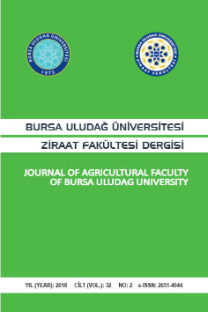Köpeklerde fertilitenin değerlendirilmesinde seminal plazma içeriğinin önemi
semen özellikleri, semen, magnezyum, analitik yöntemler, kalsiyum, spermatozoa, sperma oluşması, seminal plazma, üreme bozuklukları, kısırlık, döllenme yeteneği, köpek, tanı teknikleri, teşhis
The importance of the constituents of seminal plasma in assessing fertility in dogs
semen characters, semen, magnesium, analytical methods, calcium, spermatozoa, spermatogenesis, seminal plasma, reproductive disorders, infertility, fertilizing ability, dogs, diagnostic techniques, diagnosis,
___
1.AYDIN S, YILMAZ Y, ODABAŞI Ö, ŞEKEROĞLU R, TARAKÇIOĞLU M, ATİLLA MK. A further study of seminal plasma: Lactate dehydrogenase and lactate dehydrogenase-x activities and diluted semen absorbances. Eur. J. Chem. Clin. Biochem. 1997; 35(4):261-264.2.BELL FW, KLAUSNER JS, HAYDEN DW, LUND EM, LIEBENSTEIN BB, FEENEY DA. Evalution of serum and seminal plasma markers in the diagnosis of canine prostatic disorders. J.Vet. Intern. Med. 1995; 9: 149-153.
3.BROOKS DE. Biochemistry of the male accessory glands. In: LAMMING, G E. ed, Marshall’s Physiology of Reproduction.4th ed. Churchill Livingstone.569-90,1990.
4.CHRISTIANSEN IbJ. Reproduction in The Dog and Cat, 1st ed., Bailliere Tindall,; 81-103,1984.
5.COMHAIRE FH, DEKRESTER D, FARLEY TMM, ROVE PJ. Towards more objectivity in diagnosis and management of male infertility. Int. J. Androl. 1987; 5:5-8
6.CONCANNON WP. Reproduction in Dog and Cat. In: CUPPS P, ed. Reproduction in Domestic Animals, 4th ed. London: Academic Press. 518-550, 1991.
7.CORROZA M, GUIDI G, ROMAGNOLI S, TOGNETTI R, BUONACCORSI A. Serum total prostatic and non-prostatic acid phosphatase in healty dogs and in dogs with prostatic diseases. J.Small Anim. Prac. 1994; 35: 307-310.
8.DUBE JY, FRENETTE G, CHAPDELAINE P, RAQUIN R, TREMBLAY RR. Biochemical characteristics of the proteins secreted by dog prostate. Exp. Biol 1985; 43: 149-159.
9.ENGLAND GCW, ALLEN WE, MIDDLETON DJ. An invesigation of into the origin of the first of the canine canine ejaculate. Research in Veterinary Science 1990, 49 (1): 66-70.
10.ENGLAND GCW, ALLEN WE. The lack of effect of parvovirus vaccination on the seminal characteristics of dogs. Vet. Res. 1991; 128: 611-612.
11.FRENETTE G, DUBE JY, TREMBLAY RR. Origin of alkaline phosphatase of canine seminal plasma. Archives of Andrology 1986; 16: 235-241.
12.GARNER DL, HAFEZ ESE. Spermatozoa and seminal plasma. In: HAFEZ ESE, ed. Reproduction in Farm Animals. 6 thed. Lea & Febiger, 165-187,1993.
13.GOBELLO C, CASTEX G, CORRADA Y. Serum and seminal markers in the diagnosis of disorders of the genital tract of the dog: a mini review. Theriogenology 2002; 57:1285-1291.
14.GUSANI PH, SKANDHAN KP, VALSA C, MENTA YD. Sodium and potassium in normal and pathological seminal plasma. Acta Eur. Fertil. 1992; 23 (1): 39-42.
15.GÜNAY Ü. Farklı sulandırıcılarla sulandırılıp dondurulan köpek spermasının spermatolojik özellikleri, U.Ü. Vet. Fak. Derg., 1999; 3 (18), 149-166.
16.GÜNAY Ü, POLAT Ü, GÜNEŞ N., SOYLU MK., KIL F. The effects of short-interval ejaculation on semen quality and some biochemical parameters in dogs, Revue Med. Vet., 2003 (Baskıda).
17.JIMENEZ VERDEJO A, CARILLO DE ALBORNOZ EO, LUNA MALDONADO. A, JIME VERDEJO J, ZULUAGA GOMEZ A. Comparative study of determined biochemical parameters in vasectomized and non-vasectomised subjects. Arch. Esp. 20. Urol. 1998; 51 (8): 811-817.
18.JOHNSTON SD. Performing a complete canine semen evalution in a small animal hospital. Canine Reproduction 1991; 21: 545-550.
19.JUNIEWICZ PE, BARBOLT TA, EGY MA, FRENETTE G, DUBE JY, TREMBLAY RR. Effects of androgen and antiandrogen treatment on canine prostatic arginine esterase. Prostate 1990; 17: 101-111.
20.LINDE FORSBERG C. Artificial insemination with fresh, chilled entented and frozen-thawed semen in the dog. Seminars in Veterinary Medicine and Surgery (Small Animal) 1995; 10 (1): 48-58.
21.LINDE-FORSBERG C. Artificial insemination in the dog. W.S.A.V.A. XIXth World Congress, Durban, 606-611,1994.
22.Mc DONALD LE. Veterinary endocrinology and reproduction. In: M.H. PINEDA, ed. Male reproduction, Lea & Febiger, Philadelphia, London, 1989, 261-302.
23.MOLLO A, BOSISIO P, AVEZZA F, LUVONI CG. Concentrazione della fosfatazi alkaline nel plasma seminale del cani. Atti Societa Italiana delle Science Veterinarie 1997; LI, 171-172
24.OETTLE EE. Sperm morhphology and fertility in the dog. J. Reprod. Fertil 1993; 47:257-260.
25.OLSON PN: Exfoliative cytology of the canine reproductive tract. Theriogenology 1989; 274.
26.OLSON PN, BEHRENDT MD, AMANN RP, WEISS, DE, BOWEN RA, NETT TM, McGARRY JD. Concentration of carnitine in the seminal fluid normospermic, vasectomized, and castrated dogs. Am. J. Vet. Res. 1987; 48(8): 1211-1215.
27.REECE WO. Physiology of Domestic Animals, Lea & Febiger, 266-285, 1991.
28.ROSSI T, MAZZILI F, SARANREA N, RAPONE S, DONDERO F. The application of the differential pH method to the biochemical evalution of seminal plasma. Clinical Biochemistry 1997; 30(2): 143-148.
29.SCHUBERT CL, SEAGER, SWJ. Semen collection and evaluation for the assesment of fertility parameters in the male Dalmatian. Canine Practice 1991; 16: 17-21.
30.SINGER R, BARNET M, ALLALOUF D, SCHARTZMAN S, SAGIV M, LANDAU B, SEGENREICH E, SERVADIO C. Some properties of acid and alkaline phosphatase in seminal fluid and isolated sperm. Arch. Androl. 1980; 5: 195-199.
31.SKANDHAN K.P. Rewiew on copper in male reproduction and contraception. Rev. Fr. Gynecol. Obstet. (Review) 1992, 87: 594-598.
32.WONG YEE W, FLIK G, GROENEN PASCAL MW, SWINKELS DORINE W, THOMAS CHRIS MG, COPIUS-PEEREBOOM JENNY HJ, MERKUS HANS MWM, STEEGERS-THEUNISSEN REGINE PM. The impact calcium, magnesium, zinc, and copper in blood and seminal plasma on semen parameters in men. Reproductive Toxicology 2001;15: 131-136.
33.YI Q, KUIWU D, YANG SURNEI W, QI Z, ZHIXIN W, ZHENJIA H, MINGZHANG S. The change of carnitine content in seminal plasma after reversible injection of va deferens. Contraception 1995; 51: 261-263.
- ISSN: 1301-3173
- Yayın Aralığı: Yılda 2 Sayı
- Başlangıç: 1981
- Yayıncı: Ahmet Akkoç
Sakarya yöresi süt sığırlarında Neosporosis caninum
Taraneh ÖNCEL, Gülay BIYIKOĞLU
Donmuş boğa spermasında plazma membran sağlamlığının morfolojik bulgularla karşılaştırılması
Akut ve kronik böbrek yetmezliğine sahip köpeklerde lipid profilinin değerlendirilmesi
Sezgin ŞENTÜRK, Meltem ÇETİN, Esin GÖLCÜ, DUYGU UDUM KÜÇÜKŞEN
Teke spermasının morfolojik değerlendirilmesinde farklı boyama metotlarının kullanılması
Zekeriya NUR, ÜLGEN GÜNAY, İBRAHİM DOĞAN, Burcu BAŞPINAR, M. Kemal SOYLU
Veli Y. ÇIRAK, Ender GÜLEĞEN, Fikret YILDIRIM, Murat DURMAZ
Pastırma üretim teknolojisini geliştirme çabaları
Beyaz Yeni Zelanda ırkı tavşanların kimi spermatolojik özellikleri
Sadettin ÖZTEMEL, İBRAHİM DOĞAN, M. Kemal SOYLU
Köpeklerde fertilitenin değerlendirilmesinde seminal plazma içeriğinin önemi
